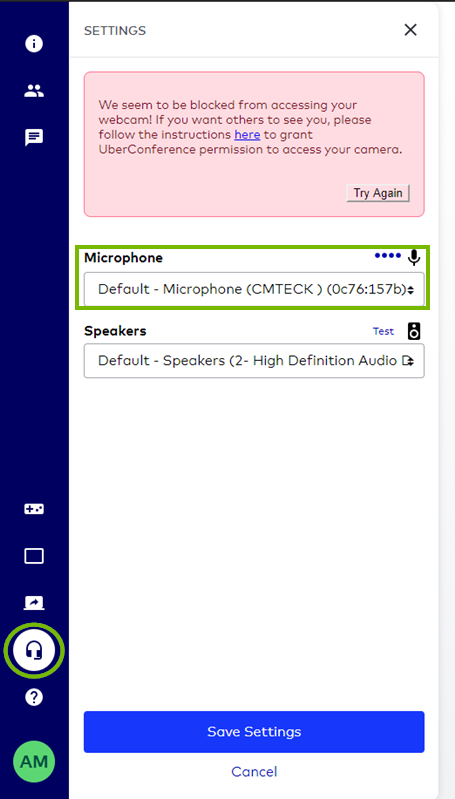Authored by: Support.com Tech Pro Team
Ever join an UberConference meeting and panic because you can't hear anyone else in the room? Maybe you were talking and found out nobody can hear you. We know where you're coming from.
Chances are, you're using web conferencing for professional reasons. No one wants to be that person who arrives late and cannot participate properly due to certain unforeseen technical issues.
This guide shows how to ensure you're using the correct speakers and microphone on Windows or Mac. Learn about browser permissions and how to make sure they are set up properly. Finally, we'll show you how to avoid causing an echo in your meeting.
Tools You'll Need:
-->
Supplies You'll Need:
-->
Before You Begin:
-->

If the microphone that's built-in or attached to your computer isn't picking up your voice, it may not be connected or configured properly. Check the following to be sure that others are able to hear you properly during your UberConference meetings.
When using external devices for your audio input, such as a headset, or USB microphone, make sure they are properly connected to your computer, are powered on and their audio levels are high enough to hear.



There's a possibility that while your microphone might not be muted, the volume level of your microphone may be set too low, causing others to not be able to hear you. The following will help you check the volume level of your microphone (sometimes referred to on your computer as the recording or input device) to be sure it is at a high enough level so that others can hear you.

To Check the Microphone Volume Level on Windows




To Check the Microphone Volume Level on Apple macOS



UberConference has a built-in mute feature you can use to stop your microphone from broadcasting while the presenter and/or other attendees are speaking. Muting while you have no intention of speaking is typical and proper video conferencing etiquette. However, if you've accidentally left yourself muted, this is a common and easy fix.
Unmuted Microphone

A white button with a microphone in it is shown when you can be heard by others.

Muted Microphone

A red button with a microphone and a line is shown when you can't be heard by others.


Since UberConference uses your browser to access your microphone you'll need to give permission to it in order to do that.
Correcting Improperly Applied Permissions
There's a bug with the Chrome browser and UberConference right now. It will only work with the speakers and microphone that were selected when Chrome was initially opened. In order to use Chrome with new mics or speakers, close Chrome, make sure your Mac knows of the new device, and then reopen Chrome.
If you've joined a meeting and others can hear you, but you can't hear any of the other participants, your audio might be muted, turned down too low, or UberConference might be trying to output sound to the wrong speakers. To resolve this symptom, check the following:

While many sets of speakers and some headsets have their own volume knobs or wheels, many users tend to forget that your computer also has its own volume adjustments, including the ability to mute sound output entirely. This is important to check.

Check Volume Levels and Muting on Windows




Check Volume Levels and Muting on Mac
For an Apple Mac you can just check the volume slider and make sure it's set to your liking.

Or you can select the speaker icon on the task bar and adjust the volume.

As was previously mentioned for microphones, your computer also has numerous 'Output' devices that it can send its audio to. Making sure your computer is sending audio to the correct device can make the difference between hearing nothing and hearing everything you expect to be hearing.

Select the Correct Audio Output Device on Windows




Select the Correct Audio Output Device on Mac



Since UberConference uses your browser to access your speakers you'll need to give permission to it in order to do use that device.
Correcting Improperly Applied Permissions
If none of the suggestions have restored audio to your speakers or headphones, reboot your computer and try again. This may seem like a useless step, but sometimes the audio services on a computer can fail. Rebooting can restart those services and potentially resolve the issue you're experiencing.
If you're still experiencing problems after a reboot, the speakers or headphones you're using may be malfunctioning. Try a different device, or reach out to the manufacturer for further assistance.
 

To Reboot a Windows Computer
Before you restart or shut down your PC, make sure to save all necessary work to prevent data loss.




To Reboot a Mac


If you hear audio echo or audio feedback during your meeting, there are 3 possible causes:
If any participants are using external speakers to listen to their meeting, their microphone may be picking up what's being played back, causing other attendees to hear an echo. If a microphone is too close to external speakers, this can cause loud audio feedback. Always recommend that users attend meetings using headphones or a headset with a built-in microphone to minimize the chances of this being an issue.
If your meeting attendees are hearing an echo, it means that someone's microphone is picking up the audio that's being played back. In most cases, this can be avoided if participants who aren't speaking simply use the Mute feature to keep themselves muted if they aren't speaking. If you are the host/presenter you can:
Additional sources that can potentially cause echo issues: